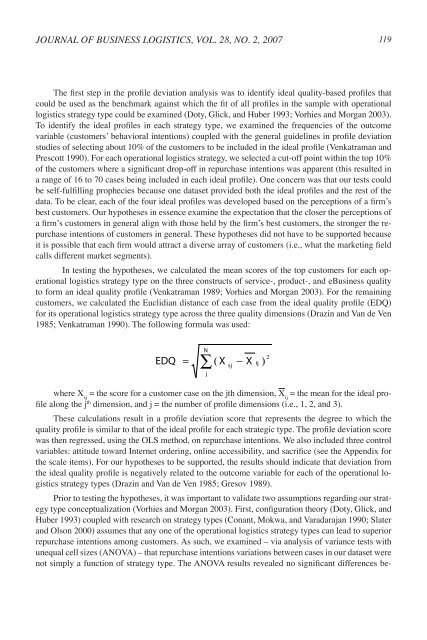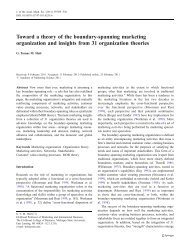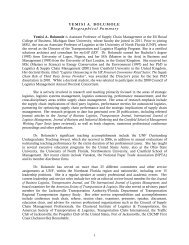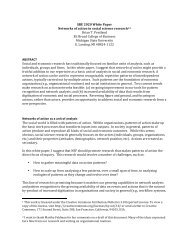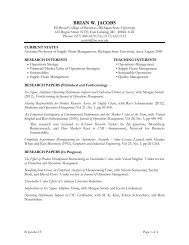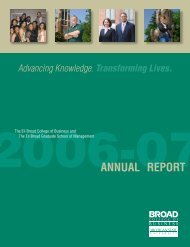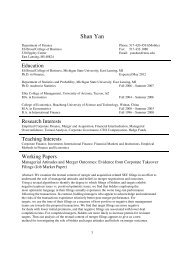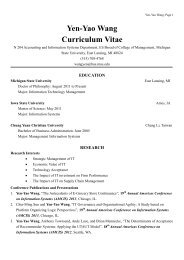Journal of Business logistics, Vol. 28, no. 2, 2007 ... - Global Initiatives
Journal of Business logistics, Vol. 28, no. 2, 2007 ... - Global Initiatives
Journal of Business logistics, Vol. 28, no. 2, 2007 ... - Global Initiatives
You also want an ePaper? Increase the reach of your titles
YUMPU automatically turns print PDFs into web optimized ePapers that Google loves.
<strong>Journal</strong> <strong>of</strong> <strong>Business</strong> Logistics, <strong>Vol</strong>. <strong>28</strong>, No. 2, <strong>2007</strong> 119The first step in the pr<strong>of</strong>ile deviation analysis was to identify ideal quality-based pr<strong>of</strong>iles thatcould be used as the benchmark against which the fit <strong>of</strong> all pr<strong>of</strong>iles in the sample with operational<strong>logistics</strong> strategy type could be examined (Doty, Glick, and Huber 1993; Vorhies and Morgan 2003).To identify the ideal pr<strong>of</strong>iles in each strategy type, we examined the frequencies <strong>of</strong> the outcomevariable (customers’ behavioral intentions) coupled with the general guidelines in pr<strong>of</strong>ile deviationstudies <strong>of</strong> selecting about 10% <strong>of</strong> the customers to be included in the ideal pr<strong>of</strong>ile (Venkatraman andPrescott 1990). For each operational <strong>logistics</strong> strategy, we selected a cut-<strong>of</strong>f point within the top 10%<strong>of</strong> the customers where a significant drop-<strong>of</strong>f in repurchase intentions was apparent (this resulted ina range <strong>of</strong> 16 to 70 cases being included in each ideal pr<strong>of</strong>ile). One concern was that our tests couldbe self-fulfilling prophecies because one dataset provided both the ideal pr<strong>of</strong>iles and the rest <strong>of</strong> thedata. To be clear, each <strong>of</strong> the four ideal pr<strong>of</strong>iles was developed based on the perceptions <strong>of</strong> a firm’sbest customers. Our hypotheses in essence examine the expectation that the closer the perceptions <strong>of</strong>a firm’s customers in general align with those held by the firm’s best customers, the stronger the repurchaseintentions <strong>of</strong> customers in general. These hypotheses did <strong>no</strong>t have to be supported becauseit is possible that each firm would attract a diverse array <strong>of</strong> customers (i.e., what the marketing fieldcalls different market segments).In testing the hypotheses, we calculated the mean scores <strong>of</strong> the top customers for each operational<strong>logistics</strong> strategy type on the three constructs <strong>of</strong> service-, product-, and e<strong>Business</strong> qualityto form an ideal quality pr<strong>of</strong>ile (Venkatraman 1989; Vorhies and Morgan 2003). For the remainingcustomers, we calculated the Euclidian distance <strong>of</strong> each case from the ideal quality pr<strong>of</strong>ile (EDQ)for its operational <strong>logistics</strong> strategy type across the three quality dimensions (Drazin and Van de Ven1985; Venkatraman 1990). The following formula was used:EDQ=N∑j( X sj− Xij2)where X sj= the score for a customer case on the jth dimension, X ij= the mean for the ideal pr<strong>of</strong>ilealong the j th dimension, and j = the number <strong>of</strong> pr<strong>of</strong>ile dimensions (i.e., 1, 2, and 3).These calculations result in a pr<strong>of</strong>ile deviation score that represents the degree to which thequality pr<strong>of</strong>ile is similar to that <strong>of</strong> the ideal pr<strong>of</strong>ile for each strategic type. The pr<strong>of</strong>ile deviation scorewas then regressed, using the OLS method, on repurchase intentions. We also included three controlvariables: attitude toward Internet ordering, online accessibility, and sacrifice (see the Appendix forthe scale items). For our hypotheses to be supported, the results should indicate that deviation fromthe ideal quality pr<strong>of</strong>ile is negatively related to the outcome variable for each <strong>of</strong> the operational <strong>logistics</strong>strategy types (Drazin and Van de Ven 1985; Gresov 1989).Prior to testing the hypotheses, it was important to validate two assumptions regarding our strategytype conceptualization (Vorhies and Morgan 2003). First, configuration theory (Doty, Glick, andHuber 1993) coupled with research on strategy types (Conant, Mokwa, and Varadarajan 1990; Slaterand Olson 2000) assumes that any one <strong>of</strong> the operational <strong>logistics</strong> strategy types can lead to superiorrepurchase intentions among customers. As such, we examined – via analysis <strong>of</strong> variance tests withunequal cell sizes (ANOVA) – that repurchase intentions variations between cases in our dataset were<strong>no</strong>t simply a function <strong>of</strong> strategy type. The ANOVA results revealed <strong>no</strong> significant differences be-


